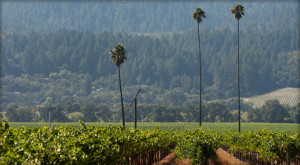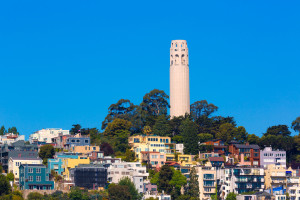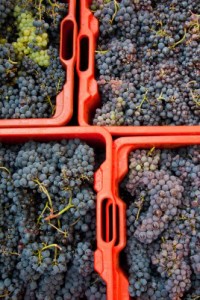Today we have a guest post by Pete Przybylinski – Sr. VP of Sales and Strategy at Duckhorn Wine Company. Pete gives us the story of the Napa Valley’s Famous Three Palms Vineyard. Pete will be sharing his story – and the wines of Three Palms – at SWE’s NOLA Conference on August 13, 2015.
“It’s not easy to say whether Duckhorn made the Three Palms Vineyard famous, or whether it was the other way around. Three Palms, situated at the northern end of the Napa Valley along the Silverado Trail, has been a star in the world of California wine since Duckhorn made its first vintage in 1978.” – Robert Whitley, October 2014
“[Three Palms] the best Merlot I have ever tasted, at least from outside Bordeaux’s Right Bank.” – Nick Passmore, May 2013
May 13th, 2015, was a very special day for all of us here at Duckhorn Wine Company. After 37 years of making wine from its coveted grapes, we proudly announced that we acquired the 83-acre Three Palms Vineyard from our longtime friends, and renowned winegrowers, Sloan and John Upton. As someone who has been with Duckhorn Wine Company for 20 years, both personally and professionally, it is incredibly gratifying that the vineyard that has always been synonymous with Duckhorn Vineyards finally took its rightful place as the crown jewel of our estate program.
Three Palms Vineyard is deservedly legendary. By almost any estimation, it is one of a handful of Napa Valley’s greatest vineyards, and is, without question, the most important Merlot vineyard in North America. Our history with Three Palms goes back to our inaugural Three Palms Vineyard Merlot in 1978. We released that inaugural vintage at the then high price of $12.50, because we wanted people to understand that it was a Merlot of exceptional quality. This iconic wine helped pioneer luxury Merlot in California, and played a pivotal role in establishing it as one of North America’s great premium varietals.
“As recently as 1978, Merlot was rarely bottled in California as a varietal wine. Duckhorn changed that. Their single-vineyard bottling from northern Napa Valley’s Three Palms Vineyard showed the heights that this grape, in the right hands, could achieve.” – Michael Apstein, April 2014
For those familiar with San Francisco and its famed Coit Tower, Three Palms has a history that predates its renown as a winegrowing site. In the late 1800s, the land that is now home to the vineyard was a residence for famed San Francisco socialite Lillie Hitchcock Coit. She called her home Larkmead, and it was there that she hosted legendary parties and numerous celebrities of the time. She left her mark on San Francisco in the form of Coit Tower. She also left her mark in Napa Valley in the form of three lone palm trees, which were all that remained from her estate after the house fell into disuse after Lillie died in 1929, at the age of 86.
In 1967, the 83-acre property was acquired by brothers Sloan and John Upton. The following year, they began planting it to Pinot Noir, Merlot, Cabernet Sauvignon, and Chenin Blanc. The site, which is located on the northeast side of Napa Valley, is in an alluvial fan created by the outwash of Selby Creek where it spills out of Dutch Henry Canyon. As a result, Three Palms is covered with volcanic stones washed down from the canyon over the centuries. The soil—what there is of it—is rocky and well drained, causing the vines to send their roots far, wide and deep to find the necessary nutrients and water. The stones in the vineyard aid the vines by absorbing the sun’s heat during the day and radiating it back to the plants during the night. This protects the vines during frost season, and helps to ripen the fruit. “People thought we were nuts,” recalls Sloan. “City slickers planting a vineyard amongst the rocks!” Time and a great deal of very hard work proved these people wrong.
“It has long defied the conventional wisdom that Merlot thrives in cooler climes but comes off dull and flabby in warmer areas. Three Palms is at the warm end of the valley, yet it consistently produces remarkable Merlot that combines firm structure with power and grace.” – Robert Whitley, October 2014
Over the years, as the Uptons grew to understand the site’s almost otherworldly ability to make profound Merlot and Bordeaux-varietal red wines, the Pinot Noir and Chenin Blanc were T-budded to more Merlot, as well as Cabernet Franc, Malbec, and Petit Verdot. Like any great vineyard, Three Palms has suffered a few setbacks and losses. In 1990, the vineyard began to show the serious effects of Phylloxera, so the long and arduous task of replanting began—the final phase of which was completed in 1999. And in 1992, the vineyard suffered the loss of one of its 105-year-old palm trees. The Upton brothers hosted a brief ceremony in which a 40-foot Washington palm was planted in its place, and since then, many of us have affectionately nicknamed the vineyard 2-1/2 Palms.
But mostly the story of Three Palms has been a testament to the phenomenal nature of this famed vineyard, and its ability to produce wines as remarkable for their structure and complexity, as for their vibrant and alluring red fruit. There are many things that contribute to the greatness of the vineyard: the meticulous farming, the Spartan bale loam soils that send the roots down as much as 18 feet in search of nutrients, the unique warm up-valley location, and more.
“Over the years, we’ve listened to the quiet voice of the vineyard, and learned what works. Part of that is about farming Three Palms for the right reasons, for love of the land, not ego. That’s a vision we have always shared with the people of Duckhorn.” -Sloan Upton
In 2011, we inked a deal for the exclusive rights to the grapes from Three Palms Vineyard, and three years later, we took over the farming. When Sloan and John decided it was time to sell, purchasing the vineyard was the natural next step. Not only has the Duckhorn Vineyards story always been tied to the story of Three Palms, our long friendship with Sloan and John has been one of the wine industry’s most successful and enduring partnerships. We are honored that they are entrusting us to carry on their life’s work, and to carry their great legacy forward.
“The iconic flagship wine that began Duckhorn’s success in 1978 is the Merlot Three Palms Vineyard, one of the first single-vineyard Merlots produced, and no doubt an inspiration for the Merlot boom in the 1980s. This has always been one of the benchmark wines for this varietal.” – Robert Parker, October 2013
While this blog has focused on the history and significance of Three Palms Vineyard, in my August 13th “Four Decades of Three Palms” conference session, I look forward to sharing more about our relationship with this vineyard, and its evolution. As we taste through some of our finest vintages spanning four decades, this will include details about changes in terms of vineyard practices, rootstock, use of oak in our winemaking, and the varying degrees of alcohol and acid in the wines—all of which have changed dramatically in the last 35 years. I am also looking forward to talking about the evolution of our marketing and sales strategies for this great vineyard and its wines, as these too have evolved dramatically over the years.
I hope to see you there!
Pete’s Session – “Four Decades of Three Palms” will be held on Thursday, August 13th, at 8:45 am as part of the Society of Wine Educators’ 39th Annual Conference, to be held in New Orleans.


